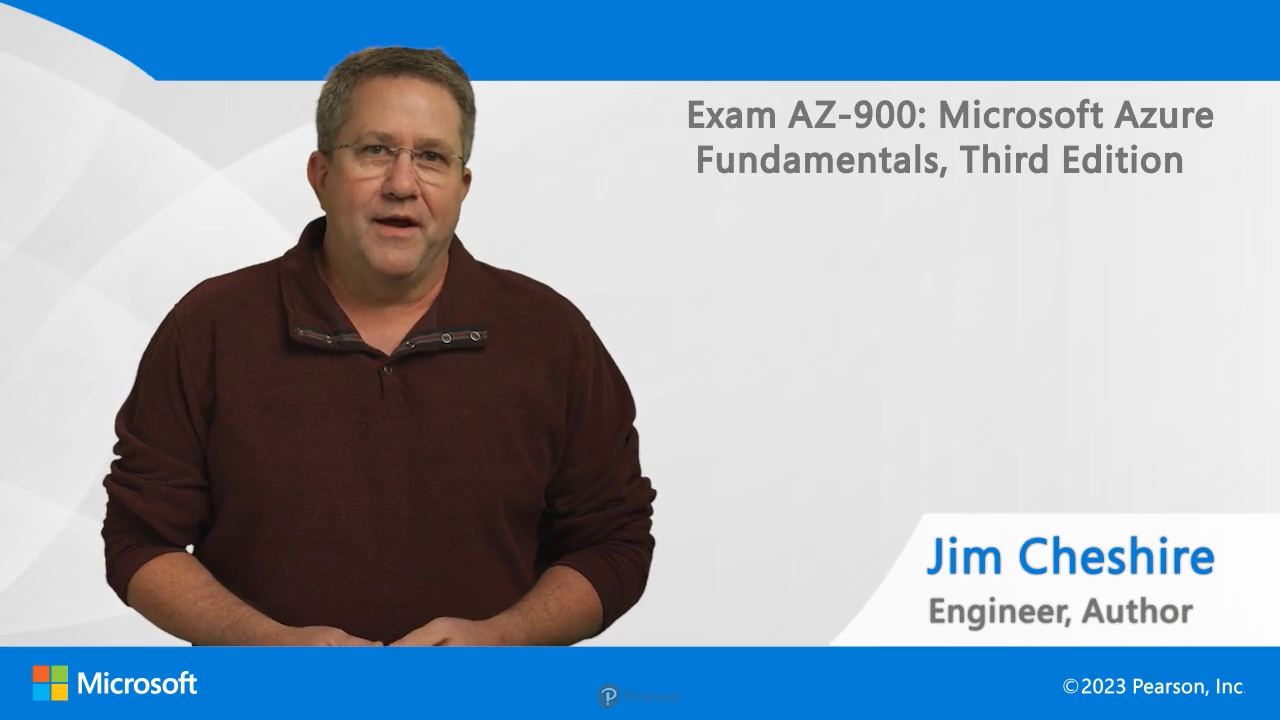- Published 3/10/2023
- 3rd Edition
- Online video 978-0-13-796972-2
4 Hours of Video Instruction
Prepare for Microsoft Exam AZ-900--updated October 2022--and demonstrate your foundational-level knowledge of cloud services and how Microsoft Azure can provide those services.
Exam AZ-900 Microsoft Azure Fundamentals (Video), Third Edition is designed for professionals in any non-technical or technical role who want to take a first step toward expanding their understanding of cloud services and cloud-based solutions using Microsoft Azure. Through expert instruction, demos, and Thought Experiments that prompt you to consider best practices in real-world scenarios, prepare for the exam and take a step forward in your career.
This video focuses on the skills measured by the exam:
- Describe cloud concepts
- Describe Azure architecture and services
- Describe Azure management and governance
For 25 years, instructor and author Jim Cheshire has worked at Microsoft in various roles, most recently in technical readiness across the entire Azure business. Jim is a bestselling Azure author and live training instructor. In this video, Jim shares his insights and organizes coverage by exam objective to help you make the most effective use of your study and exam prep time.
Skill Level
Who Should Take This Course
- Certification candidates preparing for exam AZ-900 Microsoft Azure Fundamentals
- Anyone who needs to demonstrate a foundational-level understanding of cloud services and cloud-based solutions with Microsoft Azure
- Anyone who wants to take a first step in learning Microsoft Azure concepts and terminology
Course Requirements
- This video assumes no prior knowledge of Azure or cloud services.
Table of Contents
Introduction
Module 1: Describe Cloud Concepts
Lesson 1: Describe cloud computing
Learning objectives
1.1 Define cloud computing
1.2 Describe the shared responsibility model
1.3 Define cloud models
1.4 Consumption-based model
Lesson 2: Describe the benefits of using cloud services
Learning objectives
2.1 Explain high availability and scalability
2.2 Define reliability and predictability
2.3 Describe security and governance
2.4 Explain manageability in the cloud
Lesson 3: Describe cloud service types
Learning objectives
3.1 Describe infrastructure as a service (IaaS)
3.2 Describe platform as a service (PaaS)
3.3 Describe software as a service (SaaS)
Thought Experiment: Analyzing Cloud Types
Module 2: Describe Azure Architecture and Services
Lesson 4: Describe the core architectural components of Azure
Learning objectives
4.1 Define Azure regions, region pairs, and sovereign regions
4.2 Explain availability zones
4.3 Describe Azure datacenters
4.4 Describe Azure resources and resource groups
4.5 Describe management groups
Lesson 5: Describe Azure compute and networking services
Learning objectives
5.1 Compare compute types
5.2 Describe VM options
5.3 Describe resources required for virtual machines
5.4 Describe application hosting options
5.5 Describe virtual networking
5.6 Define public and private endpoints
Lesson 6: Describe Azure storage services
Learning objectives
6.1 Compare Azure storage services
6.2 Describe storage tiers
6.3 Describe redundancy options
6.4 Describe storage account options
6.5 Identify options for moving files
6.6 Describe migration options
Lesson 7: Describe Azure identity, access, and security
Learning objectives
7.1 Describe directory services in Azure
7.2 Describe authentication methods in Azure
7.3 Describe Azure AD Conditional Access
7.4 Describe Azure role-based access control (RBAC)
7.5 Describe Zero-Trust and defense in depth
7.6 Describe Microsoft Defender for Cloud
Thought Experiment: Simple to Complex: Considering Multiple Requirements
Module 3: Describe Azure Management and Governance
Lesson 8: Describe cost management in Azure
Learning objectives
8.1 Describe factors that can affect costs
8.2 Compare the Pricing calculator and the Total Cost of Ownership (TCO) calculator
8.3 Describe the Azure Cost Management and Billing tool
8.4 Describe tags
Lesson 9: Describe features and tools for governance and compliance
Learning objectives
9.1 Describe Azure Blueprints
9.2 Describe Azure Policy
9.3 Describe resource locks
Lesson 10: Describe features and tools for managing and deploying resources
Learning objectives
10.1 Describe the Azure portal
10.2 Describe command-line tools
10.3 Describe Azure Arc
10.4 Describe Azure Resource Manager (ARM)
Lesson 11: Describe monitoring tools
Learning objectives
11.1 Describe Azure Advisor
11.2 Describe Azure Service Health
11.3 Describe Azure Monitor
Thought Experiment: Three Ps: Pricing, Performance, and Protection
Summary

